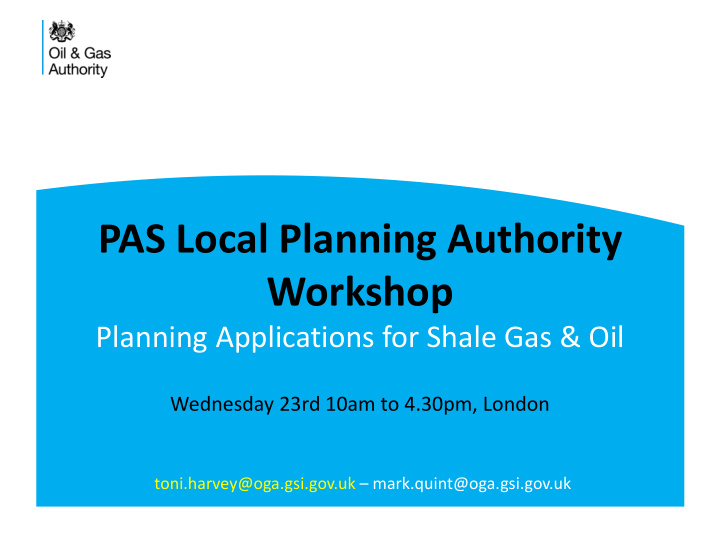



PAS Local Planning Authority Workshop Planning Applications for Shale Gas & Oil Wednesday 23rd 10am to 4.30pm, London toni.harvey@oga.gsi.gov.uk – mark.quint@oga.gsi.gov.uk
Onshore oil and gas Role of OGA with other regulators New Licensing Regulating seismicity Hydraulic Fracture Plan
UK Onshore Oil and Gas Over 2,100 wells drilled Midland Valley of Scotland Cleveland Producing fields Bowland Basin Basin • 30 Oil fields • 8 Gas fields • 2 Coalbed Methane fields Cheshire Basin East Midlands 2014 Onshore Production S Wales • 943,400 cubic meters oil Weald Basin • 47 million cubic meters gas Wessex Basin 3
UK Onshore Geophysical Library www.ukogl.org.uk 4
Regulatory Regime in England OGA award of exclusive licence after open competition Local Authority EA statutory Planning Permission consultee (with public consultation) • • EA Notices OGA online HSE • Mining waste permits application for well Notification • Abstraction licences consent • • Discharge and radioactive Hydraulic Fracture substance permits Plan submitted for a planned frac • OGA checks operator competency, Exploration insurances and Well finances 5
Petroleum Exploration and Development Licence (PEDL) • A PEDL grants exclusive rights “ to search and bore for and get petroleum ” in all the various stages of oil and gas exploration, appraisal; production and eventually abandonment of the wells. • Licences do not give permission for operations, only grant exclusivity to licensees within a defined area. • Drilling, fraccing or production require local planning permission, Access agreement(s) with relevant landowner(s), Environment Agency permits, HSE scrutiny and DECC well consent before any operations can commence • PEDL licence covers conventional oil and gas, tight gas, coalbed methane (CBM), mine vent gas, oil shale and shale gas . A PEDL licence does not allow for underground coal gasification (UCG) or CO2 sequestration. 6
Licence Rounds • To apply for a licence, the applicant submits information and later is interviewed by an expert panel who consider the Geotechnical Analysis and their proposed Work Programme, the minimum amount of work that the Applicant must carry out if the licence is not to expire at the end of its Initial Term. Their technical analysis and work programme are assessed against a published marks scheme. • Only companies with the necessary Operator Competency and Environmental Sensitivity are considered for award. OGA must also be confident that any company that receives a licence will continue in sound financial health for the foreseeable future ( Financial Viability) and has adequate Financial Capacity to cover its share of the proposed Work Programme. 7
14th Round Total Work Programme: • 58 Drill or Drop wells • 40 Firm vertical wells • 14 Firm hydraulically fractured horizontal wells • Over 2,100 km of 2D • Over 2,000 km 2 of 3D No offers in Scotland or Wales 8
Existing and 14 th Round Offers Cuadrilla PEDL165 • Shale drilling • 3D seismic • Planning at 2 sites IGAS • CBM drilling • 3D seismic 14 th Rnd Offers • 7 Firm wells bid • 2D and 3D seismic 9
BGS Methane Baseline Monitoring How does methane get into groundwater? Methane in groundwater is derived from two main sources: • biogenic methane, which is bacterially produced, and is often associated with shallow anaerobic groundwater environments, such as peat bogs, wetlands, lake sediments and landfills, although it is detectable in nearly all groundwater. • thermogenic methane, which is formed during thermal decomposition of organic matter at depth under high pressures, and is often associated with coal, oil and gas fields. In the UK most methane in groundwater is likely to be biogenic in origin, although thermogenic contributions may be locally important where gases have migrated from depth or there is slow release from previously deeply buried, low permeability, organic-rich rocks. Dissolved gas and stable isotope analysis of groundwater samples can be used to identify the different sources and potential origin of methane. (http://www.bgs.ac.uk/research/groundwater/quality/ methane_groundwater.html) 10
Frac-induced seismicity and the Hydraulic Fracture Plan (HFP)
Richter Earthquake Magnitude log scale – a whole number increase represents a tenfold increase in measured amplitude 12
BGS Historical Seismicity http://www.earthquakes.bgs.ac.uk/earthquakes/UKsignificant/index.html
Frac-induced seismicity (after Impact of Hydraulic From Styles et al 2015, Fracture Job Parameters on Schatzalp Workshop 14 Seismicity, Warpinski et al, 2012)
Hydraulic Fracture Plan 1) A depth structure map showing mapped faults near the well and along the well path, with a summary assessment of faulting and formation stresses in the area and the risk that operations could reactivate existing faults. 2) Information on the local background seismicity and assessment of the risk of induced seismicity. 3) Summary of the planned operation , including perforation stages, pumping pressures and volumes and predicted extent at each stage. Not to scale
Stimulated Rock Volume 4) Proposed method for monitoring fracture height to identify where the fractures are within the target formation and ensure that they are not near the EA permitted boundary credit: AAPG.org
Hydraulic Fracture Plan 5) A description of proposed real-time traffic light scheme for seismicity 17
• Long history of onshore oil and gas • OGA role • PEDL award only grants exclusivity no consent • Hydraulic Fracture Plan • Reduce risk of induced seismic events using Traffic Light System 18
Thanks! 19
Recommend
More recommend